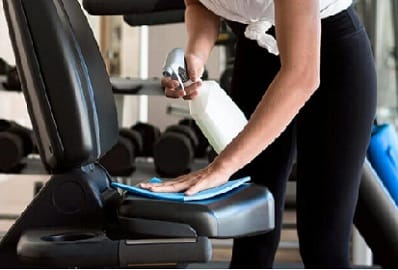
Are you using an exercise bike regularly but not seeing the results you want? One possible reason could be that you’re not properly adjusting the resistance on your bike. Adjusting the resistance is crucial to getting a good workout and achieving your fitness goals. In this article, we’ll go through the steps of how to adjust the resistance on your exercise bike to make the most of your workout.
Contents
- Why Is Adjusting Exercise Bike Resistance Important?
- Know Your Exercise Bike’s Resistance System
- Adjusting Mechanical Resistance
- Adjusting Magnetic Resistance
- Adjusting Air Resistance
- Monitoring Your Heart Rate
- Listening To Your Body
- Cleaning And Maintaining Your Exercise Bike
- Adding Variety To Your Workout
- FAQs
Why Is Adjusting Exercise Bike Resistance Important?
Before we dive into the steps of how to adjust the resistance on your exercise bike, let’s first understand why it’s important. Changing the resistance level can help you vary the intensity of your workout, making it more challenging and effective. A higher resistance level will give you a more intense workout, while a lower resistance level will be less challenging. Adjusting the resistance can also help you target different muscle groups and prevent boredom by mixing up your routine.
Know Your Exercise Bike’s Resistance System

There are several types of resistance systems on exercise bikes, and each one may have a different method of adjusting resistance. The most common types of resistance systems are:
- Mechanical resistance: This type of resistance uses a physical mechanism, such as a brake or pad, to increase or decrease resistance.
- Magnetic resistance: This type of resistance uses a magnetic field to adjust resistance levels. Magnetic resistance bikes often have buttons or a digital display to control the resistance level.
- Air resistance: This type of resistance uses the airflow from the user’s pedaling to create resistance. The faster you pedal, the higher the resistance.
Knowing which type of resistance system your exercise bike has will help you understand how to adjust the resistance.
Adjusting Mechanical Resistance
If your exercise bike uses mechanical resistance, you can adjust the resistance by turning a knob or lever. Typically, the knob or lever is located near the handlebars or under the seat. Turning the knob or lever clockwise will increase the resistance, while turning it counterclockwise will decrease the resistance. Start by adjusting the resistance to a low level and gradually increase it as you warm up.
Adjusting Magnetic Resistance
If your exercise bike uses magnetic resistance, there may be buttons or a digital display that allows you to adjust the resistance level. Some bikes may also have a knob or lever that adjusts the magnetic resistance. To increase the resistance, press the “+” button or turn the knob clockwise. To decrease the resistance, press the “-” button or turn the knob counterclockwise. Again, start with a low resistance level and gradually increase it as you warm up.
Adjusting Air Resistance
If your exercise bike uses air resistance, there may not be a way to manually adjust the resistance level. Instead, the resistance will increase or decrease based on how fast you pedal. Pedaling faster will create more airflow, resulting in higher resistance.
Monitoring Your Heart Rate
One way to ensure you’re adjusting the resistance correctly is by monitoring your heart rate. As you increase the resistance, your heart rate should also increase. Use a heart rate monitor or check your pulse to make sure you’re working at the right intensity level.
Listening To Your Body
It’s important to listen to your body when adjusting the resistance on your exercise bike. If you feel uncomfortable or in pain, decrease the resistance. On the other hand, if you feel like the resistance is too easy, increase it. Your body knows best, so always listen to it.
Cleaning And Maintaining Your Exercise Bike

Regularly cleaning and maintaining your exercise bike can help ensure that the resistance system is working properly. Check the manual for instructions on how to clean and maintain your bike.
Adding Variety To Your Workout
Adjusting the resistance on your exercise bike is just one way to add variety to your workout. You can also vary your workout by changing the speed, duration, and intensity of your pedaling. Try incorporating interval training, where you alternate between high and low resistance levels for a set period of time. You can also add in upper body exercises or incorporate music to keep your workouts interesting.
FAQs
Can adjusting the resistance on an exercise bike help me lose weight?
Yes, increasing the resistance on your exercise bike can help you burn more calories and lose weight.
What’s the best way to warm up before adjusting the resistance on my exercise bike?
Start with a low resistance level and gradually increase it as you warm up. You can also do some light stretching or cardio exercises before hopping on the bike.
How often should I clean and maintain my exercise bike?
Check the manual for specific instructions, but in general, you should clean and maintain your exercise bike at least once a month.
Is it okay to use an exercise bike every day?
Yes, as long as you’re not over-exerting yourself and allowing for proper recovery time, it’s okay to use an exercise bike every day.
Can adjusting the resistance on my exercise bike help prevent injuries?
Yes, by gradually increasing the resistance level and listening to your body, you can help prevent injuries and ensure a safe workout.
Conclusion
Adjusting the resistance on your exercise bike is an important aspect of achieving your fitness goals. By knowing your bike’s resistance system and listening to your body, you can ensure that you’re getting the most out of your workout. Varying your resistance level and adding variety to your workout can also help prevent boredom and keep you motivated.





